Cagliari added yet another casualty to their transfer merry-go-round recently when Italian tactician Leonardo Semplici was relieved from his duties back in September after losing all twice and drawing once in their opening three matches of the season.
Semplici won six of his 18 games in charge and helped the Sardinian side to stave off relegation last season.
This season, Cagliari were rock bottom of Serie A when Semplici was replaced, and the board were on the lookout for an experienced manager that could help them repeat the feat of the previous campaign.
The Casteddu landed on Walter Mazzarri, a household name in Italian football. The ex-Watford manager had been out of work since he was sacked by Torino two seasons ago.
So far, as of writing, Cagliari have played eight games under the guidance of the 60-year-old but have won just once, drawing twice and losing on five occasions. The team are still sitting at the bottom of the top-flight division and have one of the worst defensive records in the league which could be a massive hindrance for Mazzarri in his bid to keep them up.
This article will be a tactical analysis of Cagliari this season in the form of a team scout report. It will be an analysis of their defensive tactics, looking at what has gone wrong for the Italian side.
Formation and personnel
As is typical with most sides that are struggling to get results, the choice of formation so far this season has fluctuated from game to game. Mazzarri also has quite a habit of changing the team’s structure in and out of possession depending on the situation.
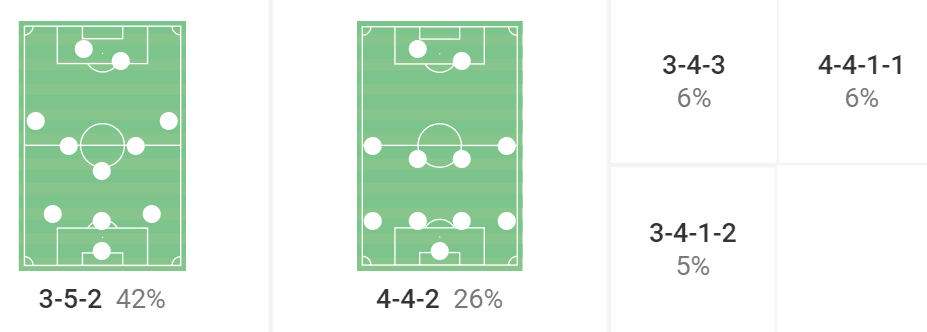
The 3-5-2 has been the most utilised formation for Cagliari so far this season and has been deployed in 42 percent of the side’s matches with the 4-4-2 being the second most commonly used system with 26 percent.
There has been a common theme with Mazzarri though that is rather interesting. The 3-5-2 has been his preferred system for quite a long time. However, with Cagliari, a pattern has emerged that shows the 60-year-old tends to switch to a 4-4-2 when the 3-5-2 is not working which occurs quite often.
It is clear that the manager is struggling to find the system that gives his team the greatest defensive security in games. So far, Cagliari have the third-highest expected goals against (xGA) in total in Serie A this season after eleven matches with 18.2. They are also conceding the highest volume of shots per 90 in the league with 14.6.
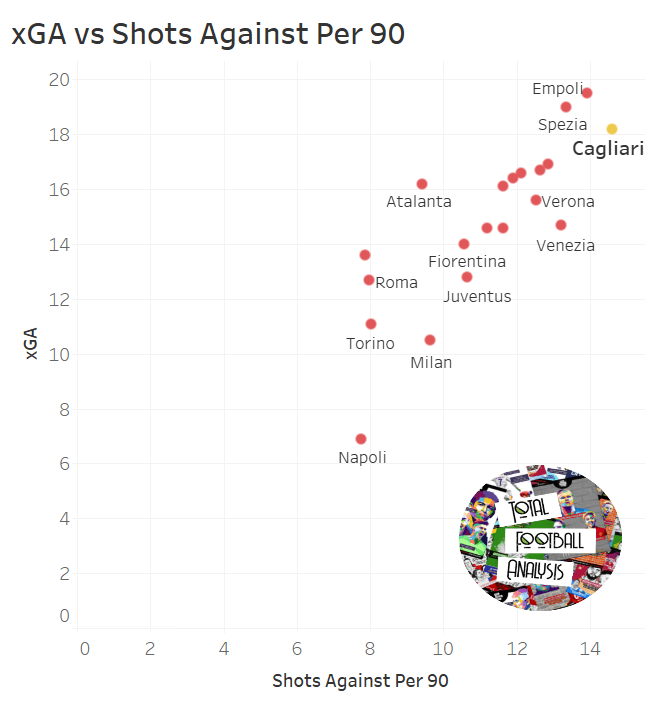
Mazzarri does have the players to play a back three due to the number of centre-backs within the squad but the Sardinian team also have fullbacks and wingers that can play as wide defenders too which gives them that flexibility.
In their most commonly used 3-5-2 formation, which becomes a 5-3-2 in the deeper defensive phases, Mazzarri tends to use this starting lineup:
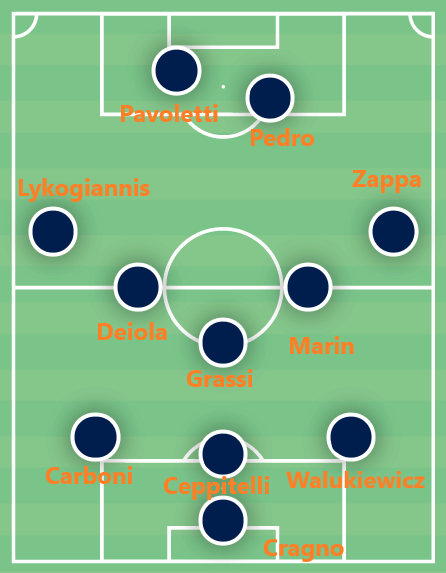
As already stated, typically when this formation doesn’t work, Mazzarri will take one of the three central defenders off and revert to a back four.
However, when Cagliari begin a game in a 4-4-2, the Italian coach tends to deploy very Jose Bordalas-esque double-fullbacks on the flanks. This essentially means that the Casteddu will play two fullbacks as wide midfielders and, of course, the two fullbacks in a back four.
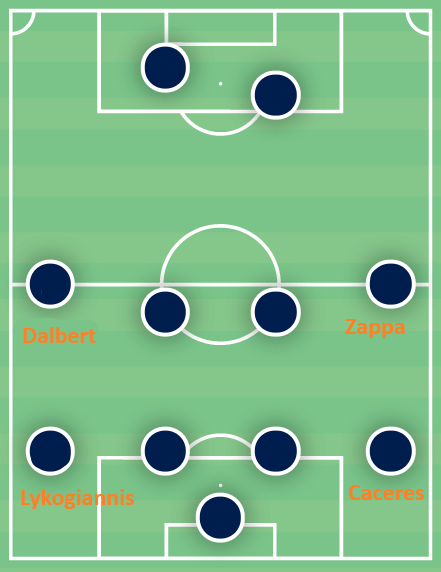
Generally, the more attacking fullbacks will play as the wingers, but it gives Cagliari defensive security by essentially having four defensive players in the wide areas. Well, in theory, it would give them defensive security, but this is not so much the reality.
No pressing and easy to play through
Cagliari do not press high at all under Mazzarri. The Italian manager is notorious for being quite a pragmatic and conservative coach. In fact, Cagliari are averaging the fifth-least amount of pressures in the attacking third per 90 in Serie A so far this season with 28.7.
Essentially, this means that when the attacking team has possession of the ball in the first third of the pitch, Cagliari skips the high pressing phase and immediately drop into a defensive mid-block.
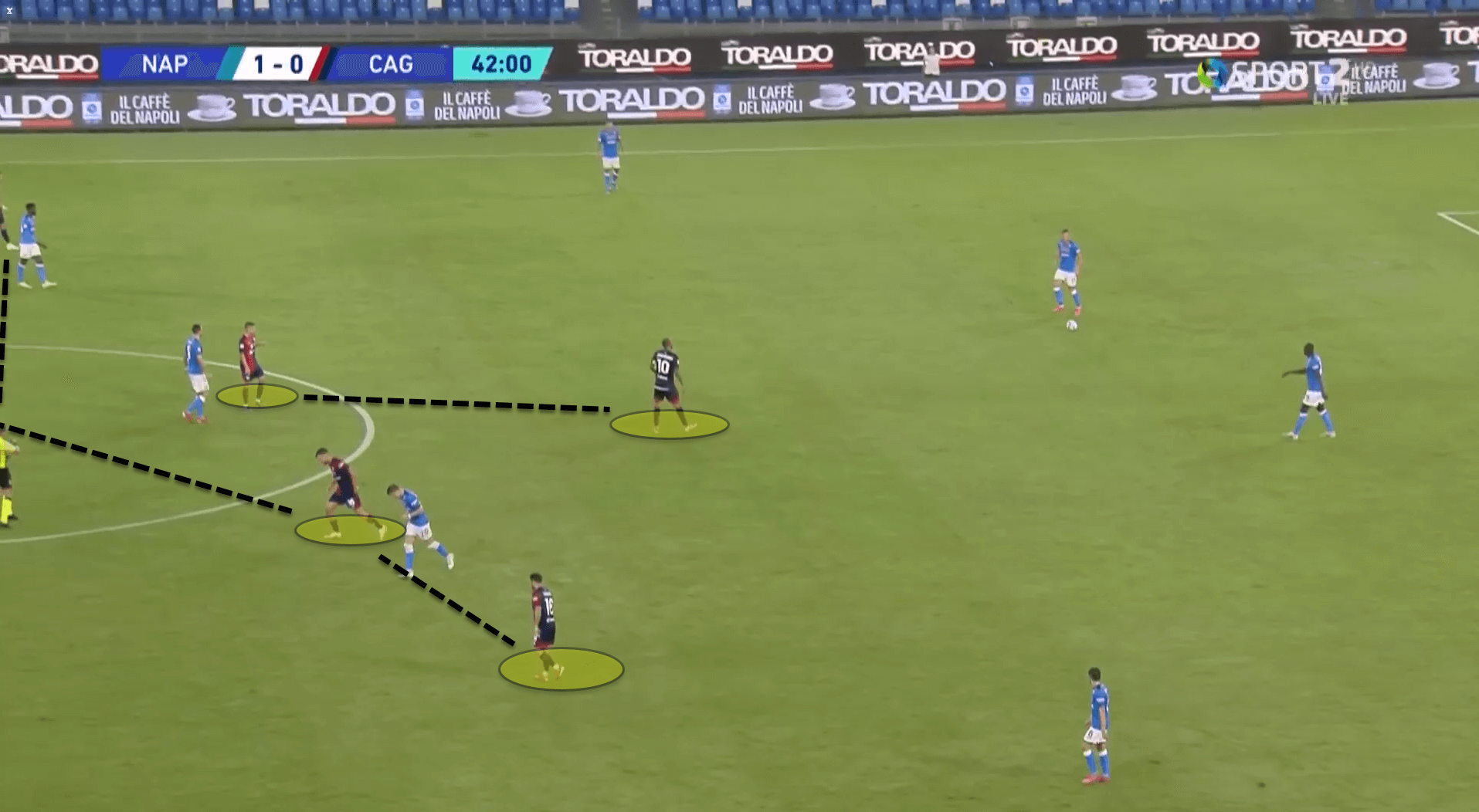
Here is an instance where Napoli have the ball in the build-up phase of their attack. Cagliari’s players can be seen dropping back into their 4-4-2 mid-block instead of pressing the centre-backs.
Putting pressure on the opposition high up the pitch leaves gaps and spaces for the attacking team to play through when executed poorly. Mazzarri doesn’t want to risk this, and so Cagliari prefer to drop deeper, stay compact and prevent the opponent from play through them.
Once again, in theory, this seems ideal. A well-organised defensive medium or low block will be very compact between the lines and the distances between the players will be minimalised in order to ensure that the team can properly shift across from side to side to cover the width of the pitch.
However, the most important element of a compact block is the denial of space between the lines as it prevents goalscoring opportunities in the central areas.
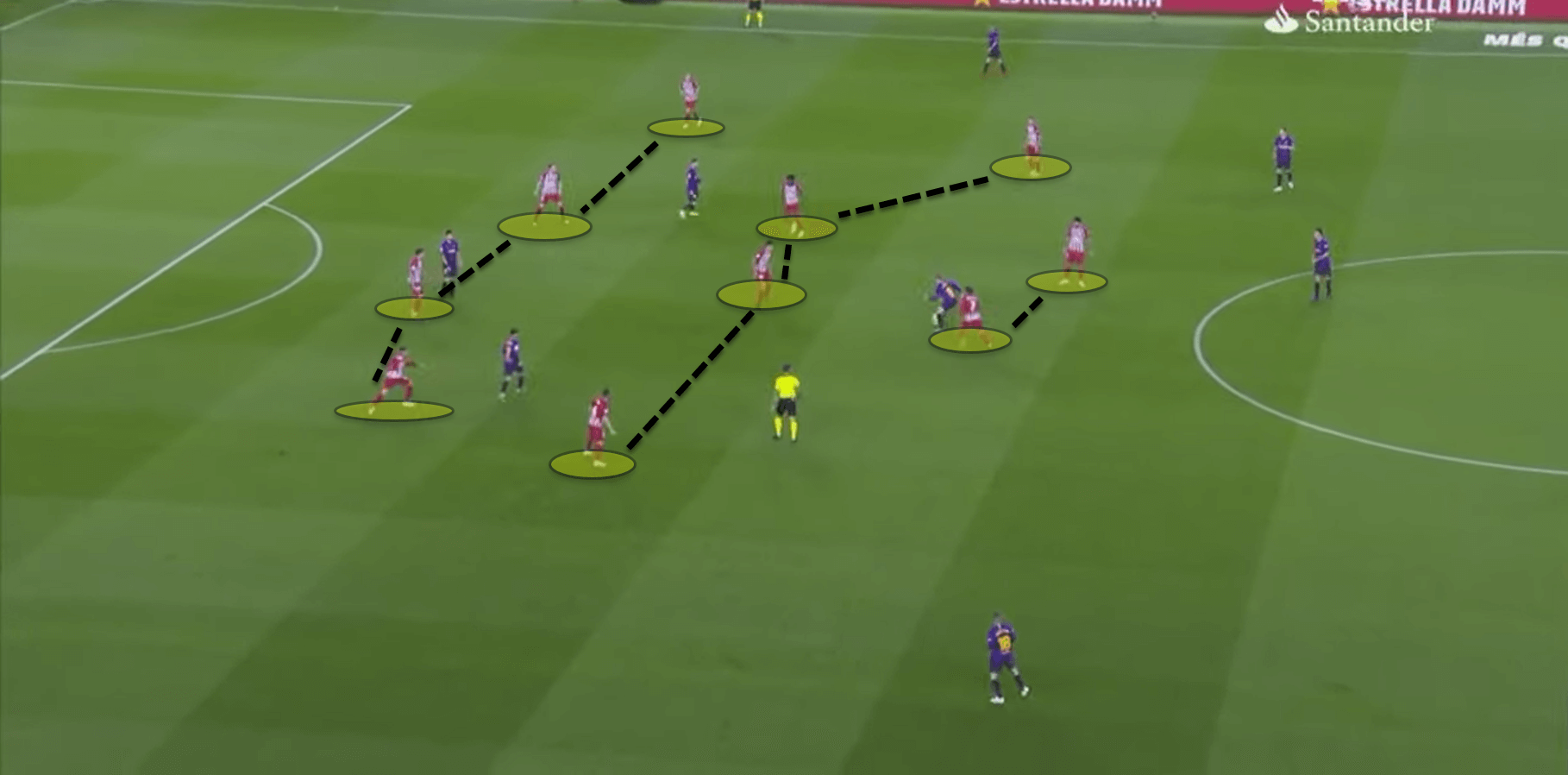
This is an example of how a compact 4-4-2 defensive block should look, denying the opponent any space between the lines and leaving space out wide to entice them to play into these areas.
Now, let’s take a look at how Cagliari look when sitting in a deeper defensive block using the same principles as any other defending team in this area of the pitch.

There is far too much space between the lines for Fiorentina to progress the ball through the right halfspace here. Either the backline needs to push further up to close the space, which could be risky as it allows a direct ball to be played over the top of them, or else the midfield line needs to drop deeper and stagger.
Staggering is an extremely important principle in the defensive phases to stop a team from progressing the ball to the area between the midfield and backline.
Staggering is when one central midfielder drops deeper than his/her partner, allowing them to play more zonally when defending, picking players up between the lines.
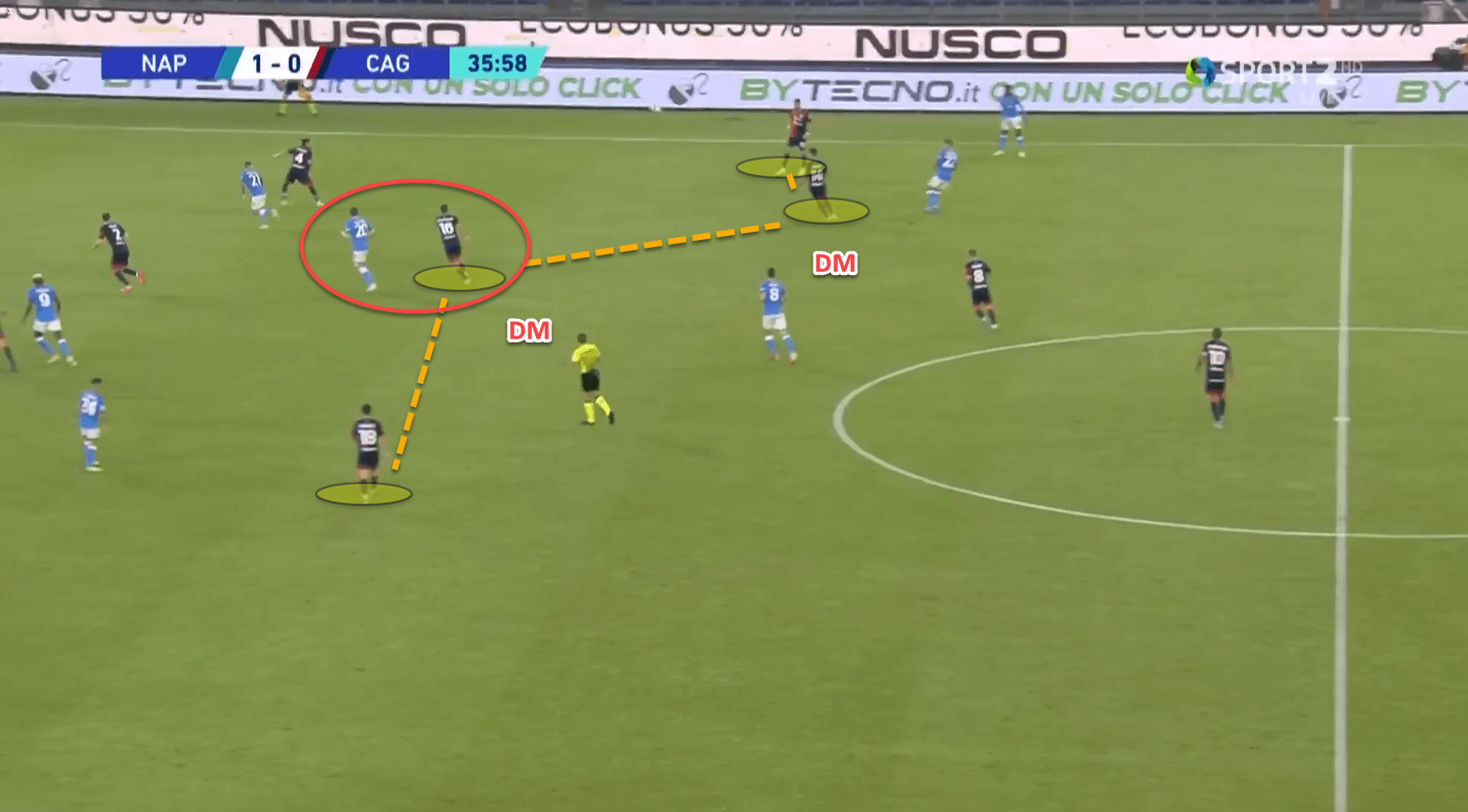
Here is an instance where Cagliari’s defensive structure was solid. The Serie A strugglers are compact between the lines, which forces Napoli to go direct.
The double-pivot have also staggered with the ball-far pivot player dropping deeper and playing zonally, picking up a player between the lines and blocking the passing lane to him.
However, more often than not, their defensive block is structured poorly which makes them far too easy to play against. Cagliari are far too passive in the middle third too. Mazzarri’s side averages 59.5 pressures in the middle third per 90, one of the lowest tallies in Serie A this season.
The players look far too passive at times and lack simple defensive awareness and discipline for the most part which allows the opposition to easily carve them open, particularly when retreating into their defensive shape.
Mazzarri does not want his players to counterpress. Instead, Cagliari drop back into defensive shape as quickly as possible, although calling it ‘quick’ would be an insult to well-structured teams.
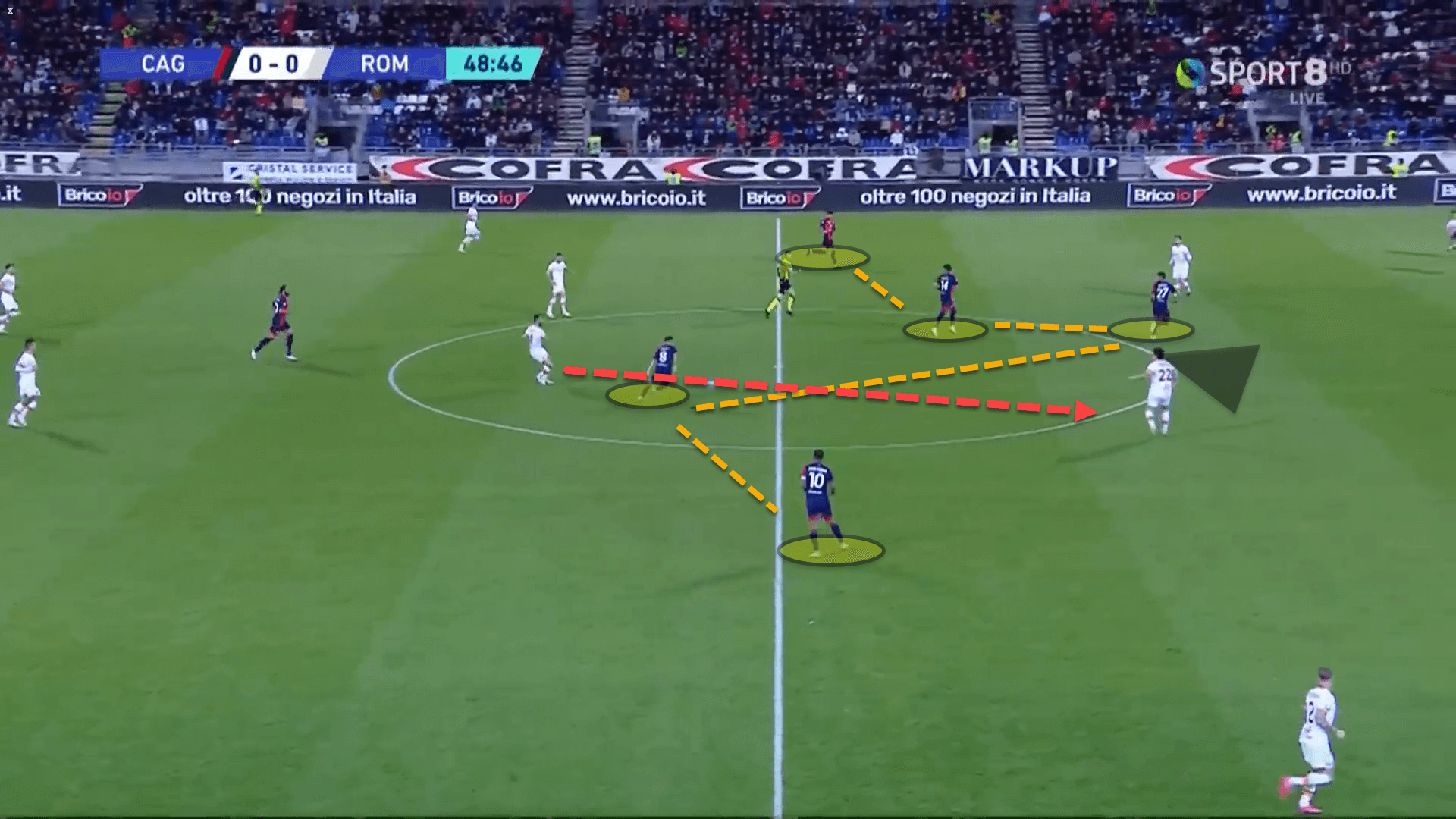
Here, Cagliari have lost possession and are retreating into their defensive block. While the AS Roma midfielder is splitting their entire midfield open, the players are still retreating and are completely unaware of the attacking player who is receiving the ball between the lines. The players need to be far more reactive in these crucial defensive phases.
Easy to carve open out wide
As is common-place with almost all teams when defending, the players must stay compact between the lines to force the opposition to play out wide. Once the attacking side shifts the ball to the flanks, the team out of possession must use the touchline to their advantage and either navigate possession backwards into harmless areas or else try and win back possession.
Cagliari deploy these principles, but the execution is horrendous at times and can cause them severe problems as it makes progression to the final third simple for the opposition.
Getting back to the use of the double-fullbacks, this is supposed to help them in this regard, but it has not quite paid off yet.
One of the reasons for this is how disjointed and uncoordinated the different defensive lines are.
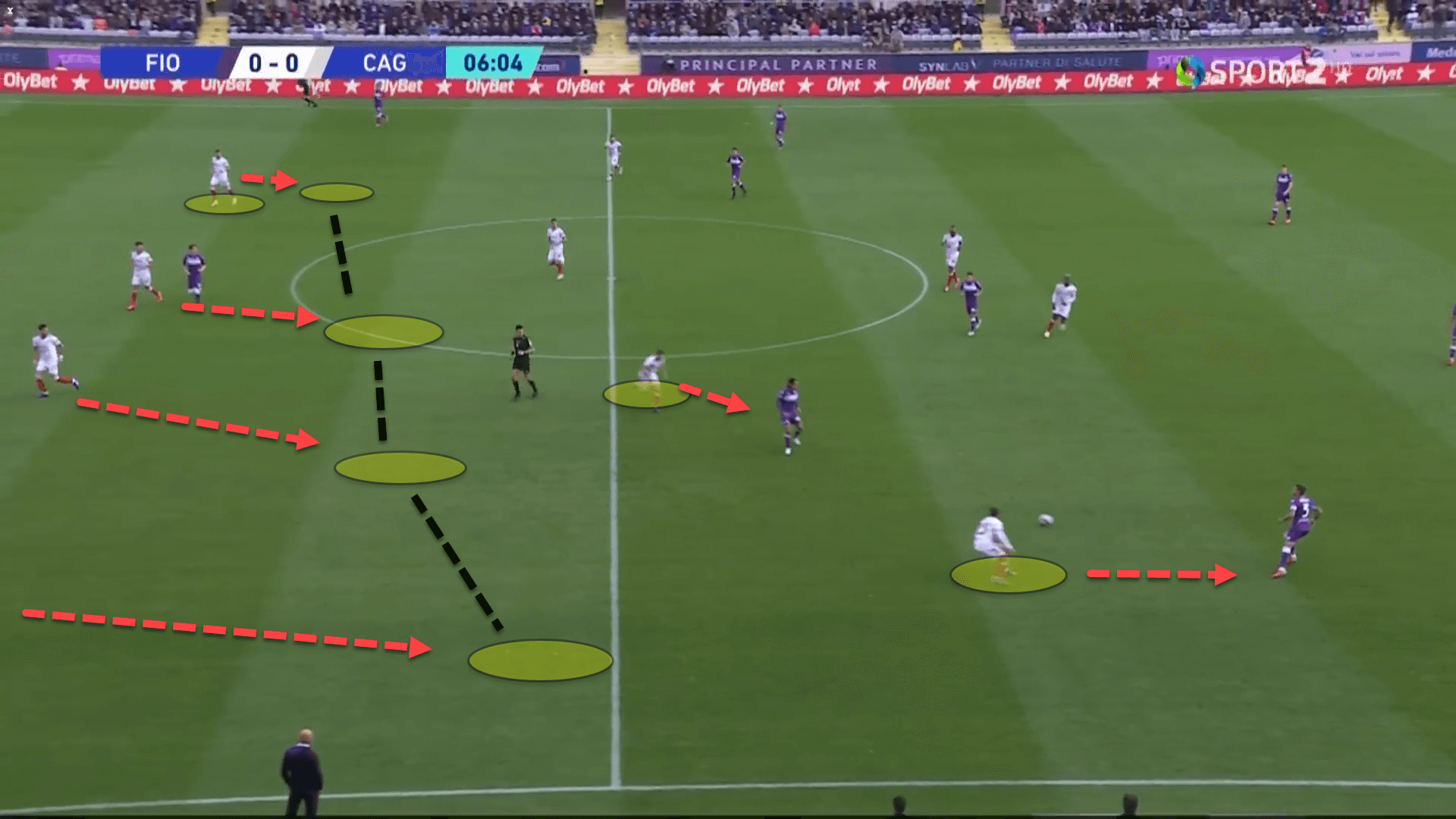
Again, this comes to the issue of staggering. When the ball is in the wide areas and the defensive block shifts across, the backline must stagger its positioning in order to ensure that it is not easy to play through.
In the previous image, Fiorentina are looking to break down Cagliari’s mid-block by playing out wide and the player who is receiving the ball has plenty of space to play a one-time pass out wide to the winger who is dropping to receive.
The backline should be way higher and at an angle to suffocate any space that the opposition has to play into. The positions that the back four should be in to make it difficult for the opponent to play out wide have been highlighted in the image too.
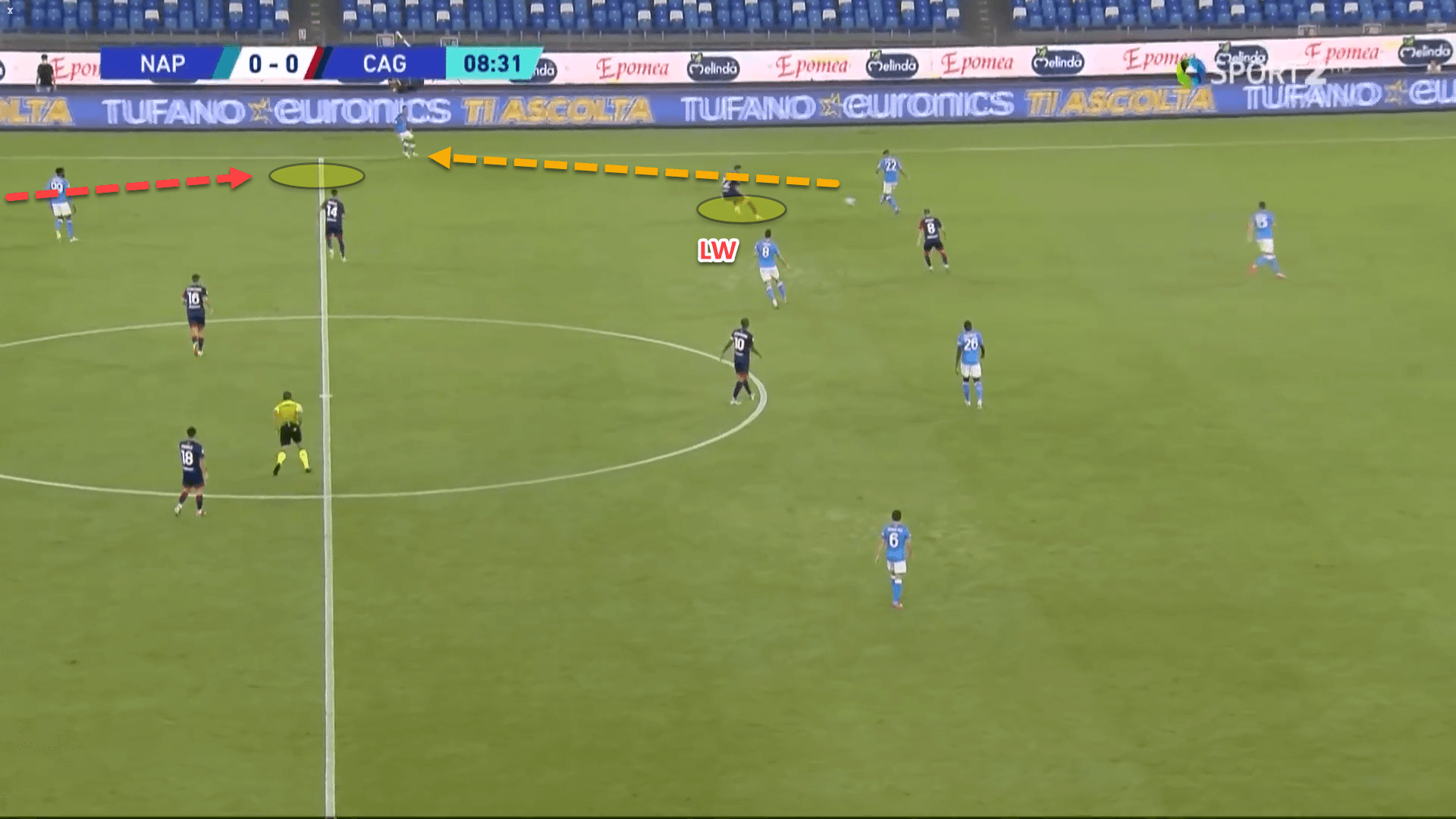
Again here, the left-winger has moved out of the midfield line to put pressure on the player in possession, angling his run to force him out wide which is successful.
However, when the Napoli fullback receives the ball, Cagliari’s left-back does not push up to close him down to stop him from opening up his body and playing down the line. Instead, the backline is flat and the player on the ball simply turns and plays it over the top for the striker making a run in behind.
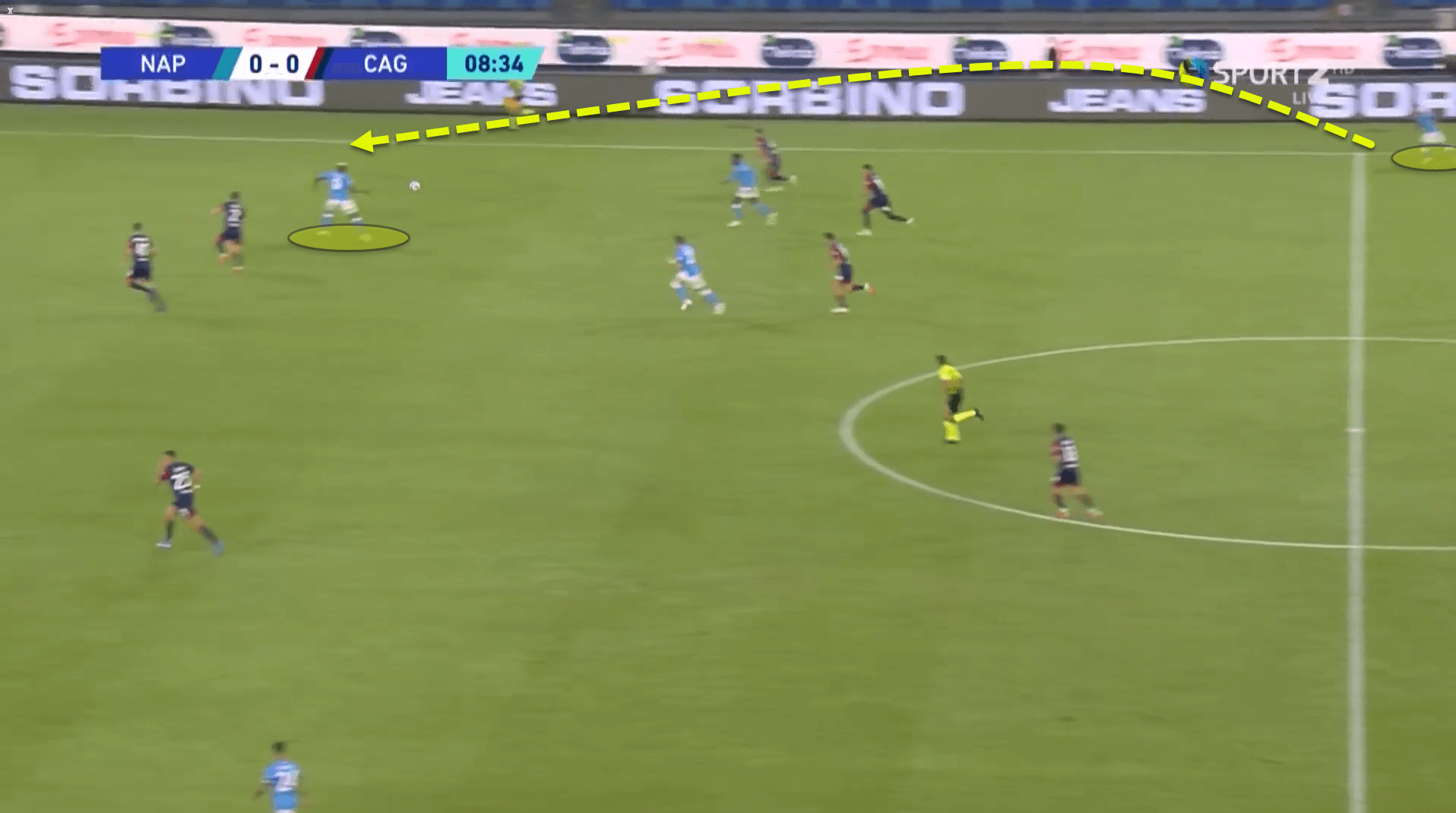
The defensive lines must work in unison to avoid situations like this. When cover is needed, the backline should push across to help out and angle their line instead of staying flat.
Often when a team is defending, one of the lines will break down. One of the other defensive lines must help out so that the defensive block works in unison. Cagliari’s defensive block does not work in unison. This needs rectification on the training ground quickly.
Slow reaction in the final defensive phase
Cagliari hold a Passes allowed Per Defensive Action ratio this season so far of 16.65 which is the highest in Serie A bar none.
The relegation-battlers also have the lowest pressure success percentage in Italy’s top-tier which portrays that even when the players do put pressure on the ball, it is generally worthless.
This shows up in their reactions to second balls in and around the penalty area. Reaction defending is one of the most instinctively important attributes for a team when defending their goal.
If a ball is cut back to the edge of the box, the players must react quickly and push out to close down the ball to either block a shot, a pass, or a ball back into the area. Cagliari tend to stay in and around the box on top of the goalkeeper. This is a basic principle of defending that the players are failing to adhere to.
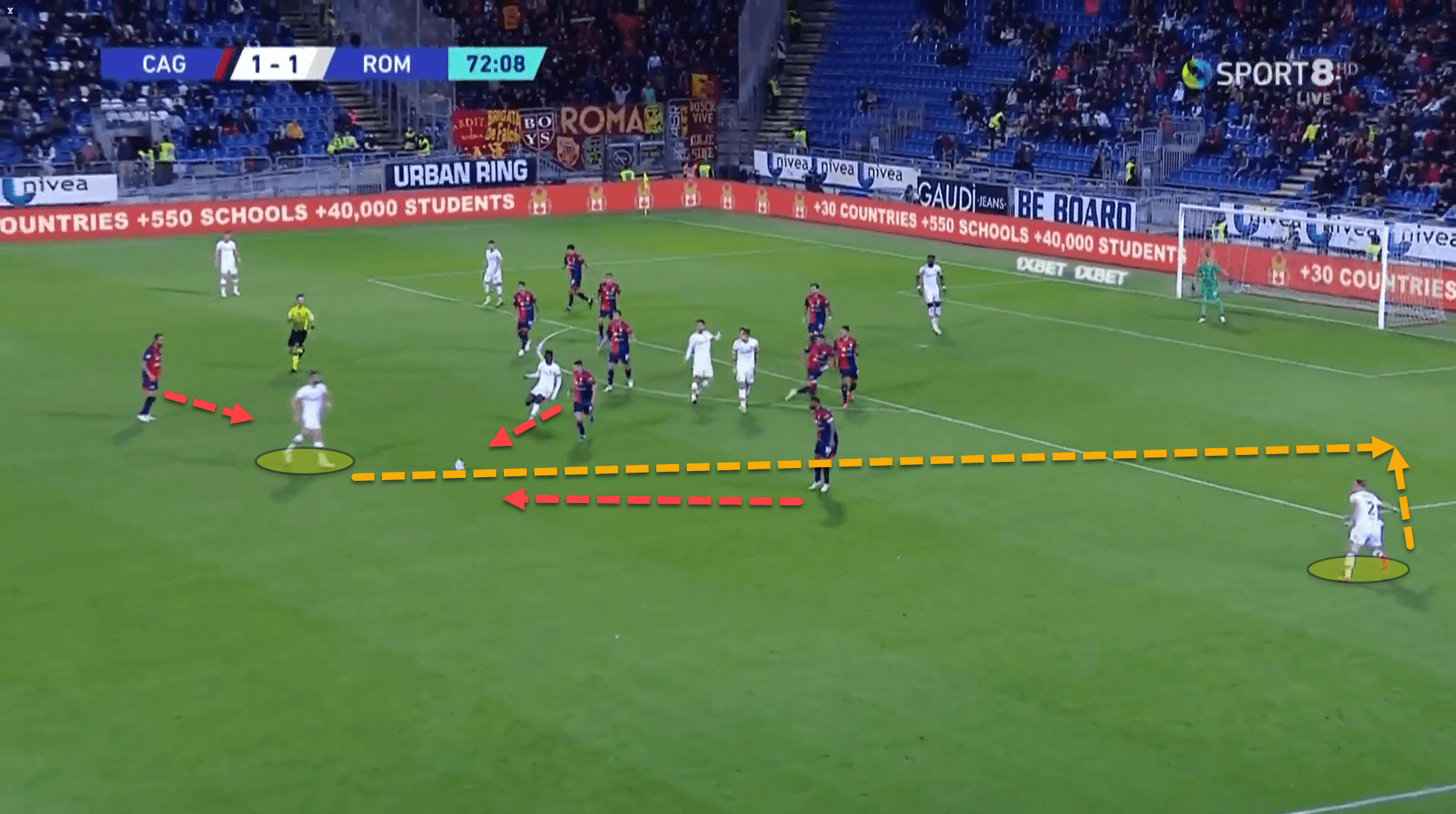
Here, the ball has come out to the edge of the area after it was originally crossed into the box. There are three players standing around the player in possession and yet little to no pressure is applied to the ball.
The ball-carrier slips it in behind to the wide-man and the opposition are now have a great opportunity to score.
The most worrying sign from this image is the poor body language of the players. Some are standing still in positions that do not allow them to react quickly whatsoever.
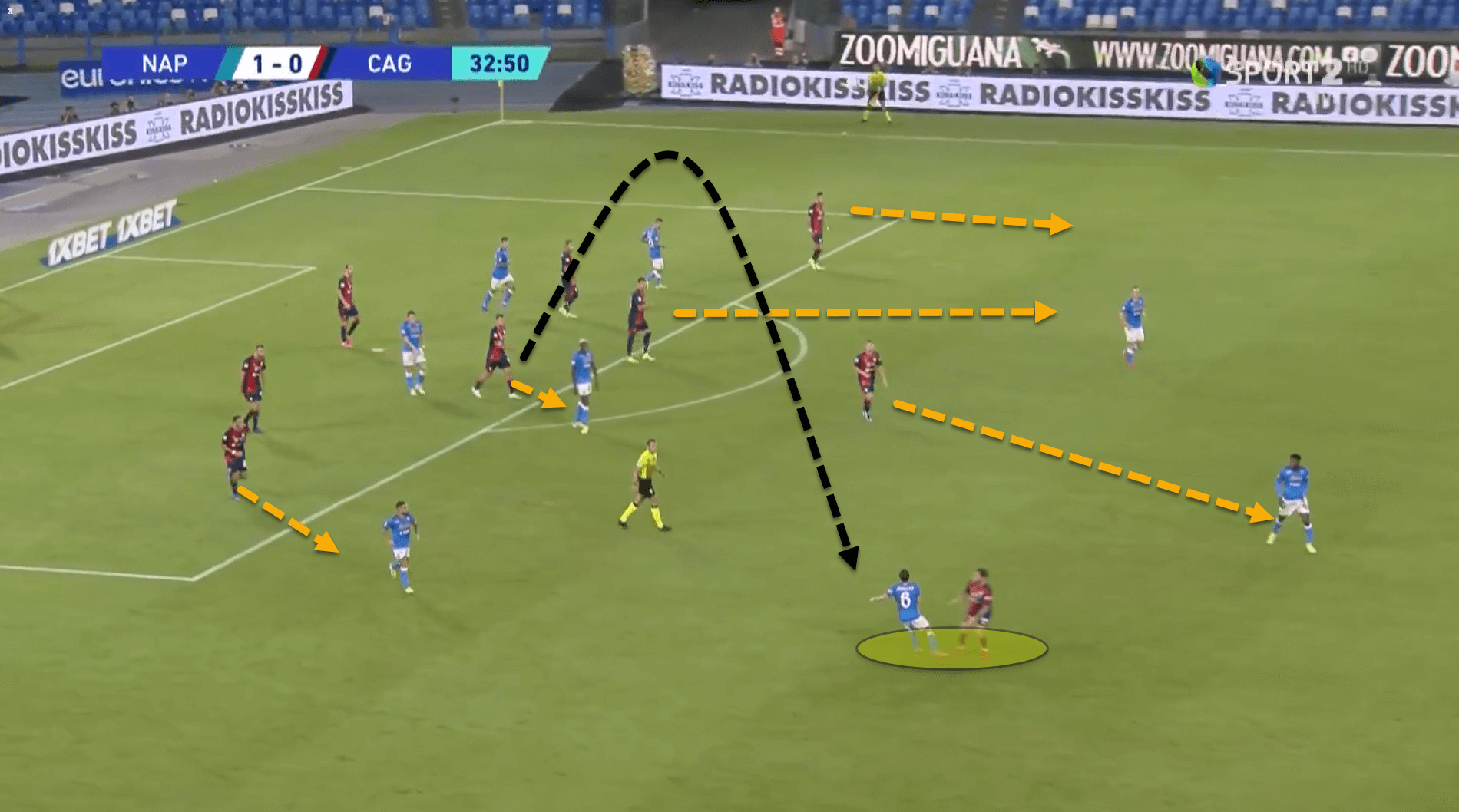
Here is another example of his poor reactionary defensive play in and around the box. Cagliari have cleared the ball in this instance and instead of quickly pushing out to suffocate the ball, Mazzarri’s men saunter out to the edge of the area.
From there, as the Cagliari player contesting the aerial duel is outnumbered, Napoli regains possession easily by winning the header, and then the second ball, and Cagliari are being pinned back against their goal once more.
This is such a dangerous way for any team to live. When an opportunity for respite rises by either pushing higher up the pitch to stop defending so deep, it must be taken. Cagliari don’t ever seem too bothered when they clear the ball out of the box.
If you are a side like 2010 Internazionale under Jose Mourinho, perhaps defending your goal for a full ninety minutes is doable, but certainly not a team who have picked up just one victory all season.
Conclusion
Mazzarri was brought in to help Cagliari escape relegation following Semplici’s sacking, but somehow the Sardinian side look worse off than before.
No amount of formation changes will be able to fix Cagliari’s poor defensive displays this season. There are severe structural issues within the team that need rectifying as soon as possible and the players need their confidence rebuilt or else Mazzarri will find himself unemployed very soon.






Comments